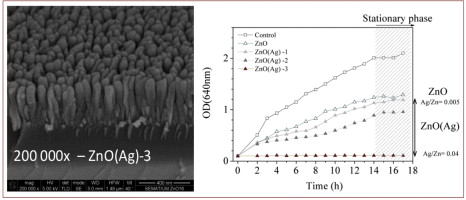P. Carvalho, P. Sampaio, S. Azevedo, C. Vaz, J.P. Espinós, V. Teixeira, J.O. Carneiro
Applied Surface Science, 307 (2014) 548-557
doi: 10.1016/j.apsusc.2014.04.072
In this research work, the production of undoped and silver (Ag) doped zinc oxide (ZnO) thin films for food-packaging applications were developed. The main goal was to determine the influence of coatings morphology and thickness on the antimicrobial performance of the produced samples. The ZnO based thin films were deposited on PET (Polyethylene terephthalate) substrates by means of DC reactive magnetron sputtering. The thin films were characterized by optical spectroscopy, X-Ray Diffraction (XRD), X-ray photoelectron spectroscopy (XPS) and Scanning Electron Microscopy (SEM). The antimicrobial performance of the undoped and Ag-doped ZnO thin films was also evaluated. The results attained have shown that all the deposited zinc oxide and Ag-doped ZnO coatings present columnar morphology with V-shaped columns. The increase of ZnO coatings thickness until 200 nm increases the active surface area of the columns. The thinner samples (50 and 100 nm) present a less pronounced antibacterial activity than the thickest ones (200–600 nm). Regarding Ag-doped ZnO thin films, it was verified that increasing the silver content decreases the growth rate of Escherichia coliand decreases the amount of bacteria cells present at the end of the experiment


